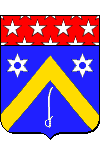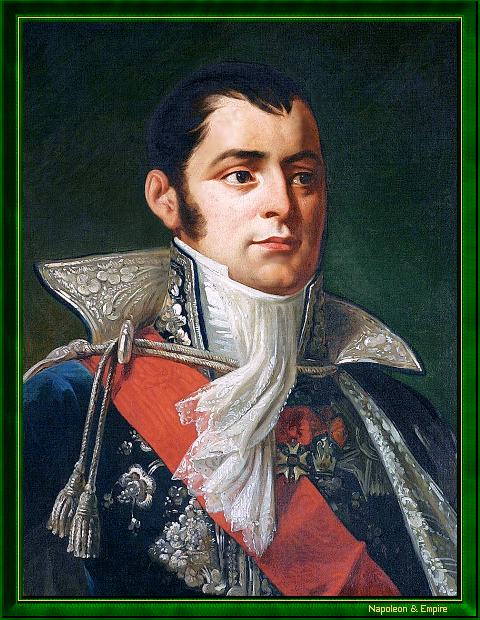First Duke of Rovigo
Pronunciation:

The son of a soldier, Anne-Jean-Marie-René Savary joined the Royal Normandy Regiment as a cadet in 1790 in time to participate in the suppression of the unrest in Nancy when the garrison rebelled against its aristocratic officers. He transferred first to the Rhine Army, then to Egypt and finally to Italy. He served most often as an aide-de-camp for Jean-Charles Pichegru, Jean Victor Marie Moreau and finally Louis Charles Antoine Desaix.
After Desaix's death at Marengo (June 14, 1800), he reported the news to Napoleon Bonaparte. Named aide-de-camp to the First Consul, he earned Napoleon's trust and friendship through his absolute obedience and was soon entrusted with sensitive duties: investigating the kidnapping of Senator Clément de Ris (from which Honoré de Balzac drew the inspiration for his novel "Une ténébreuse affaire" ["A Murky Business"]) and spying on royalist dissenters (the Chouans).
As a result, he was promoted to Colonel. He took command of a legion of specially trained officers charged with the protection of the First Consul. He also commanded a unit of military police tasked with the surveillance of other soldiers. These responsibilities caused him to frequently quarrel with Joseph Fouché and Bon-Adrien Jeannot de Moncey.
René Savary married Marie Charlotte Félicité de Faudoas Barbazan de Segnanville, a cousin of the Polignacs, on February 27, 1802, with whom he fathered seven children.
Promoted to Brigadier General on August 29, 1803, he participated in the execution of the Duke d'Enghien on March 21, 1804. In fact, it was René Savary who was tasked with carrying out the death sentence handed down by the Military Commission.
In 1805, he was made Major General (général de division) and distinguished himself on the battlefield for his courage and valour. He informed the Emperor of the enemy's formation before the Battle of Austerlitz (December 2), seized the fortress of Hamelin (November 20, 1806), won a brilliant victory over the Russians at Ostrolenka (February 16. 1807), and led a glorious charge at Friedland (June 14).
When the peace treaty was signed at Tilsit (July 8, 1807), Savary was sent to Saint Petersburg to ensure the secret clauses of the treaty were carried out. He turned out to be a second rate diplomat preceded by his reputation as the "executioner of Vincennes" which saw doors slammed in his face.
He returned to France in January 1808, received the title Duke of Rovigo and was sent to Spain in March. This time, his mission was to convince the Spanish royals to accompany him to Bayonne. Succeeding in his mission, he returned to Madrid where he replaced Joachim Murat (who had become ill) as interim commander in the country while awaiting the arrival of Joseph Bonaparte. He left when the new King arrived.
While Fouché's star was setting, Savary's continued to rise. He was now one of the intimate confidants of the Emperor, with Hugues-Bernard Maret, accompanying Napoleon everywhere. As such, on June 3, 1810 Napoleon I made Savary his new Minister of Police. His nomination caused considerable concern since the new Minister was suspected of being far less flexible than his predecessor even toward the wealthy and well connected.
After some initial difficulties, caused by the destruction wrecked by Fouché when he left the Ministry, Savary rebuilt the espionage service and threw himself into the hunt for dissidents. Madame de Staël, Madame Récamier or the Duchess de Chevreuse as well as the high officials who were imprisoned in the dungeons of Vincennes paid the price for Savary's zeal. Arrests were commonplace and the situation in Paris became almost unbearable.
However, in 1812 Savary was unable to react to the coup d'état organised by General Malet (October 23). He was arrested and taken to prison by the conspirators without any resistance. Though he became the subject of considerable ridicule after this incident, he maintained the confidence of the Emperor.
He rewarded this trust in 1814 when he was one of the few to remain loyal to Napoleon I until the very end. After the abdication, he made no attempt to approach the Bourbons and spent the entire first Restoration in the country.
During the Hundred Days, he was quick to offer his services to the Emperor and became Inspector General of the Police, a position that put him at the head of the Emperor's secret police.
Loyal until the end, he attempted to follow Napoleon I to Saint Helena but was arrested by the English on-board HMS Bellerophon and imprisoned on Malta. He escaped after seven months and became a businessman in Smyrna since he could not return to France as he had been officially exiled on July 24, 1815 and condemned to death in absentia in December 1816. He was able to return, however, in 1819 after a partial amnesty was declared. He appeared before a War Council and was acquitted with his titles restored but remained unemployed until the July Revolution.
Louis-Philippe I made him Commander-in-Chief of the troupes occupying Algeria. Though he was resolved to "pacify" the country, he did not hesitate to resort to the most violent means at his disposal. He was responsible for the massacre of the El Ouffia tribe on April 7, 1832. He left his post on April 1833 due to illness and died two months later.
The Duke's modest tomb can be found in the 35th division of the Père Lachaise Cemetary in Paris.
"Anne-Jean-Marie-René Savary, Duke of Rovigo" by Robert Jacques François Faust Lefèvre (Bayeux 1755 - Paris 1830).

Savary seems to have had a certain penchant for disguises despite his otherwise unimaginative personality. He is known to have made use of disguises twice in his career: when he was spying on the Chouans for the Consulate and when he had to escape the uprising in Spain in 1808.
His name can be found on the 14th column (east side) of the Arc de Triomphe.
The Mémoires of the Duke of Rovigo in eight volumes, published in 1828, are a legitimate primary source regarding events under the Consulate and First Empire even if the author intended, naturally, to justify his own actions during such controversial episodes as the imprisonment and execution of the Duke d'Enghein, the death of Pichegru and the Malet affair.
Acknowledgements
Other portraits

Enlarge
"Anne-Jean-Marie-René Savary, Duke of Rovigo". Engraving of nineteenth century

Enlarge
"General Savary". Engraving of nineteenth century